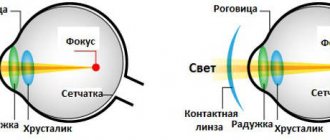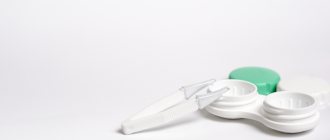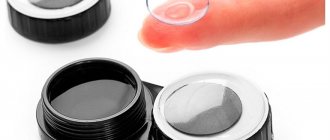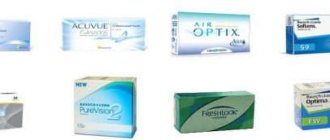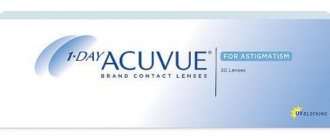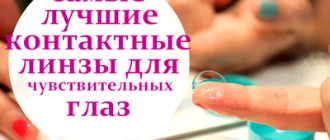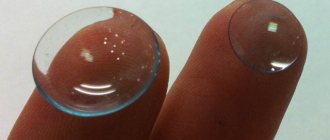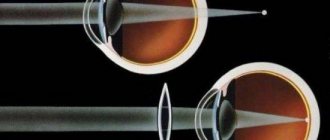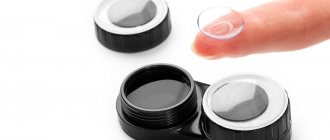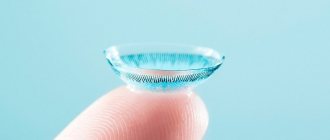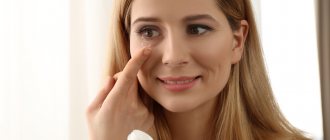In childhood, the choice between glasses and lenses should be made especially carefully. Relationships with peers, the child’s self-esteem, and his safety depend on it. Therefore, you will have to take into account many factors, pros and cons of both types of correction and determine which one is preferable.
The choice of correction method for a teenager is determined by three main aspects:
- cosmetic;
- comfort;
- safety.
Having studied the advantages and disadvantages of glasses and lenses in relation to these aspects, it will be easier to decide on a method.
Find out from your teenager
A study by Plowright et al* included 110 adolescent patients (ages 13 to 19 years) who were randomly assigned to wear either daily contact lenses or glasses for six months [1 ].
Clinical and quality of life indicators were assessed through slit-lamp examination, logMAR visual acuity, and questionnaire responses. Subjects were also asked to share their opinions about contact vision correction.
Pros and cons of spectacle correction
Glasses have the following advantages:
- ease of use and care;
- a small number of contraindications;
- Can be worn for infectious diseases (flu, ARVI).
There are also a number of disadvantages:
- Difficulty wearing with an active lifestyle;
- limited angle of view;
- glass fogging;
- Difficulty in choosing sunglasses.
Benefits of wearing contact lenses as a teenager
According to the study, participants reported improvements in their appearance, increased satisfaction with vision correction and participation in activities, and positive changes in peer perception [1]. The results obtained are consistent with previous studies showing that contact vision correction can improve the quality of life of both children (aged 8 to 11 years) and adolescents (aged 13 to 17 years) [2, 3].
Contact correction can improve the quality of life of adolescents, and research confirms this
In addition to directly improving quality of life, there is compelling evidence that wearing certain contact lenses can slow the progression of myopia in children and adolescents [4]. In such patients, reduction of myopia has a positive effect throughout life [5].
Now let's move on to consider contact optics.
Pros:
- do not limit when playing sports;
- increase the field of view;
- no need to select lenses according to your face shape;
- variety of types by material, wearing mode, functional indicators;
- Can be worn with sunglasses.
Cons of contact lenses:
- longer and more thorough care;
- a large number of contraindications.
Benefits of wearing daily contact lenses during adolescence
Adolescence is a unique time characterized by significant hormonal changes, increased overall stress and increased incidence of physiological disorders, as well as increased susceptibility to certain inflammatory diseases such as acne. If we talk about contact vision correction, there is an increased risk of complications and corneal infiltrates in users aged 14 to 25 years [6, 7]. The impact of systemic changes (stress, immune response) is not well understood, but there is evidence of differences in patient behavior and environmental influences during adolescence [8]. The work of Plowright et al. stated that adverse events were observed in only four of 47 patients who completed a six-month contact lens trial. None of the events caused vision loss, but they did result in corneal scarring. Many studies have demonstrated the greater safety of daily disposable contact lenses compared with routine replacement lenses [6, 7, 9]. Because most contact lens non-adherence behaviors and environmental exposures can be minimized or eliminated through the use of daily disposable lenses, this wearing regimen has clear benefits for at-risk populations. Other benefits of disposable contact lenses include improved comfort and visual acuity, as well as a reduction in solution-induced toxic and allergic reactions [10]. Data from the present study also support these benefits. After six months of daily wearing of daily contact lenses, the subjects had good visual acuity[1]. Finally, a study by Plowright et al. and other studies show that children and adolescents not only can successfully wear contact lenses, but also like to use daily lenses if given the opportunity.
Not only can children and teenagers wear contact lenses successfully, but they also enjoy wearing daily lenses if given the opportunity.
A short-term trial of these contact lenses improved adolescents' attitudes toward their vision and contact lens wear [1]. Similarly, the majority of children aged 8 to 11 years reported that they “never have a problem” or “usually have no problem” putting on, removing, or handling daily contact lenses [11]. At the end of the study, 63% of children and 80% of adolescents continued to wear contact lenses, and more than 80% of children and adolescents indicated that they preferred contact lenses to glasses [12]. The cost of contact lenses was the main reason given by parents for their children to stop wearing them [12].
Types of contact lenses
Before choosing contact lenses for a teenager, we recommend that you familiarize yourself with their varieties.
There are the following types of contact optics:
- Soft contact lenses. They are suitable even for particularly sensitive eyes. When wearing them, patients feel comfortable. Soft lenses are used to correct refractive errors such as myopia, farsightedness and mild astigmatism.
- Hard contact lenses are indicated for farsightedness, nearsightedness and all types of astigmatism. They provide high quality vision and can be used for keratotonus, after ophthalmological operations and corneal injuries. It takes longer to get used to them than to soft lenses, this is quite justified. In some patients, wearing gas permeable hard contact lenses delays the progression of myopia. They last quite a long time.
- Hybrid contact lenses have two components: a hard center that provides clear vision, and a soft “skirt” that fits over the eye. They are prescribed to patients who are intolerant of rigid gas permeable contact lenses to correct all types of visual impairment.
There are four types of contact lenses according to the duration of wear:
- daytime;
- prolonged (can be worn without removing for 6-7 days);
- continuous (wear up to 30 days);
- “flexible mode” (they can be left on for no more than two nights in a row).
Some soft contact lenses contain UV filters. They reduce the damaging effect of ultraviolet rays on the lens and prevent the development of cataracts. These lenses cannot replace sunglasses because they only protect the part of the eyeball that is under the lens.
Tinted contact lenses are considered creative. With their help, you can either shade or radically change the color of your eyes. Some fashionistas use tinted lenses to give their look the magnetism of cat eyes. At the request of the patient, special coatings are applied to contact lenses that increase image contrast. This is especially important for athletes as it increases their reaction speed in sports games.
Whatever contact lenses you choose, they require proper care. Only in this case there will be no complications when wearing them. In order to feel comfortable wearing contact lenses, you should also follow the regimen prescribed by your doctor. The choice of a specific type of contact lenses for teenagers should be made by an ophthalmologist.
Prescribing contact lenses for teenagers
Given these benefits, it is not surprising that daily disposable lenses are increasingly being fitted to younger patients. An international survey of specialists in contact vision correction showed that worldwide the proportion of all contact lenses fitted to minors compared to those fitted to adults varies from 1 to 25% [13]. About 25% of children and 20% of adolescents are fitted with daily contact lenses, but these numbers also vary by country [13]. Given the increasing incidence of myopia worldwide, pediatric contact lens fitting has significant growth potential. There is growing evidence of the benefits of fitting daily contact lenses to adolescents. However, practitioners should be aware of the potentially higher risk of complications in this demographic subgroup and educate patients and parents on how to minimize the risks and maximize the benefits of contact lens wear.
Bibliography
1. Plowright AJ, Maldonado-Codina C, et al.
Daily disposable contact lenses versus spectacles in teenagers. Optom VisSci 2015; 92:44–52. 2. Rah MJ, Walline JJ, et al. Vision specifi c quality of life of pediatric contact lens wearers. Optom Vis Sci 2010; 87:560–6. 3. Walline JJ, Jones LA, et al. Randomized trial of the effect of contact lens wear on self-perception in children. Optom Vis Sci 2009; 86:222–32. 4. Giff ord P, Giff ord KL. The Future of myopia control contact lenses. Optom Vis Sci epub ahead of print Dec 2015. 5. Flitcroft DI. Th e complex interactions of retinal, optical and environmental factors in myopia aetiology. Prog Retin Eye Res 2012; 31: 622–60. 6. Wagner H, Chalmers RL, et al. Risk factors for interruption to s oft contact lens wear in children and young adults. Optom Vis Sci 2011; 88:973–80. 7. Chalmers RL, Wagner H, et al. Age and other risk factors for corneal infi ltrative and inflammatory events in young soft contact lens wearers from the Contact Lens Assessment in Youth (CLAY) study. Invest Ophth Vis Sci 2011; 52:6690–6. 8. Wagner H, Richdale K, et al. Age, behavior, environment, and health factors in the soft contact lens risk survey. Optom Vis Sci 2014; 91:252–61. 9. Stapleton F, Keay L, et al. The epidemiology of contact lens related infiltrates. Optom Vis Sci 2007; 84:257–72. 10. Hickson-Curran S, Spyridon M, et al. Th e use of daily disposable lenses in problematic reusable contact act lens wearers. Cont Lens Anterior Eye 2014; 37:285–91. 11. Walline JJ, Long S, et al. Daily disposable contact lens wear in myopic children. Optom Vis Sci 2004; 81:255–9. 12. Jones LA, Walline JJ, et al. Purchase of contact lenses and contact-lenses-related symptoms following the Contact Lenses in Pediatrics (CLIP) Study. Cont Lens Anterior Eye 2009; 32: 157–63. 13. Efron N, Morgan PB, et al. Survey of contact lens prescribing to infants, children, and teenagers. Optom Vis Sci 2011; 88:461–8. * Daily disposable contact lenses versus spectacles in teenagers / AJ Plowright, C. Maldonado-Codina, GF Howarth, J. Kern, PB Morgan // Optometry and Vision Science. 2015. N 92. P. 44–52.
Author: K. Richdale, Associate Professor, Director, Clinical Center for Vision Research, State University of New York College of Optometry (USA), Modern Optometry, 2, 2016
Comfort and safety
If we take these factors into account, then the child will be more comfortable and safer wearing contact lenses. Firstly, his age will require him to be active both in school physical education classes and just on the street. Playing sports with glasses is inconvenient and dangerous for the eyes, as there is a risk of injury. Secondly, having peripheral vision in lenses, which is limited in glasses, will ensure safety when crossing the road or riding a bicycle.
In addition, proper selection of lenses and care for them will protect against possible complications.
The ophthalmologist must decide on the method of correction in each case. Independent choice can lead to vision complications. The doctor will conduct a diagnosis and give the necessary recommendations. Perhaps the option of alternating wearing glasses and lenses will suit you: wear the first at home, wear the second on the street.
